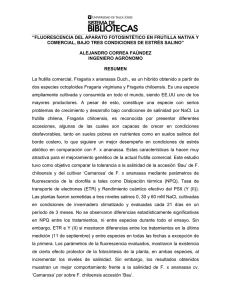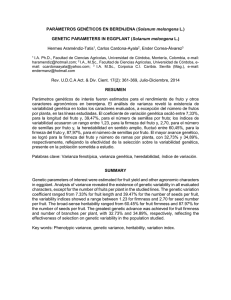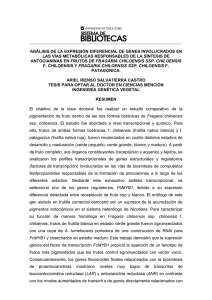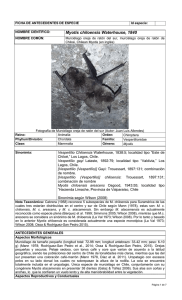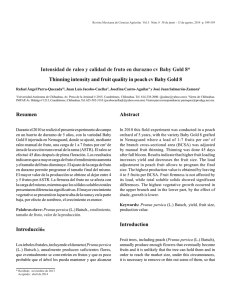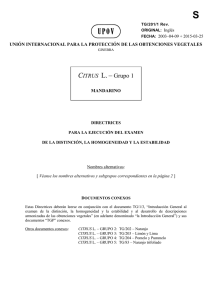“CARACTERIZACIÓN ESTRUCTURAL DE FcXTH1 y FcXTH2
Anuncio
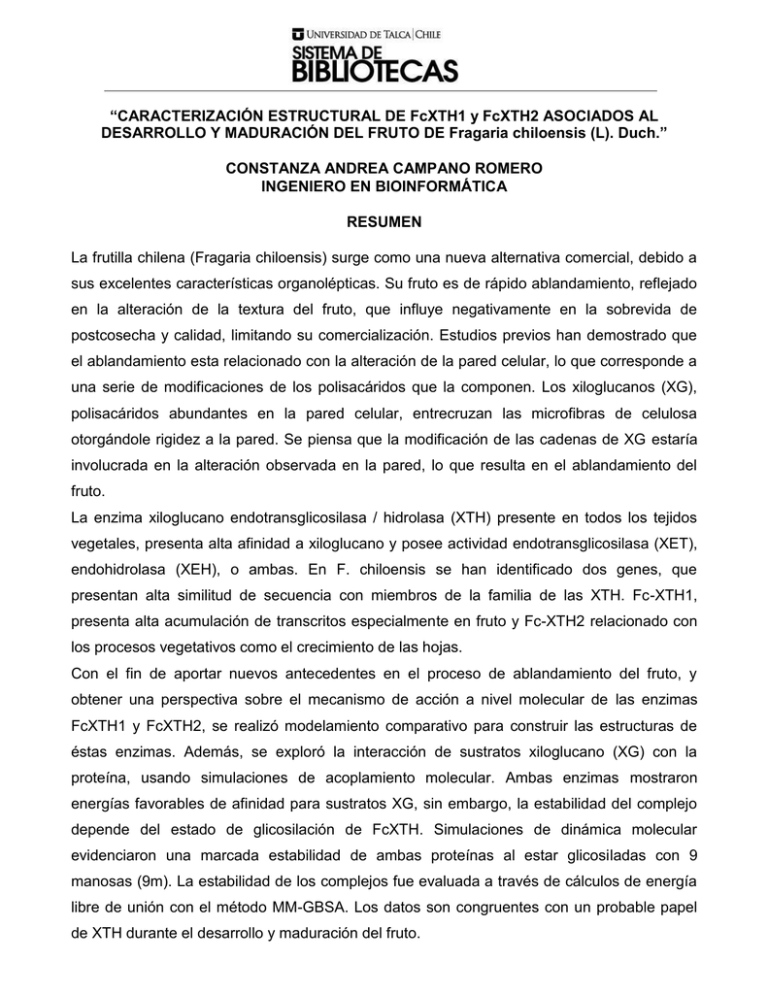
“CARACTERIZACIÓN ESTRUCTURAL DE FcXTH1 y FcXTH2 ASOCIADOS AL DESARROLLO Y MADURACIÓN DEL FRUTO DE Fragaria chiloensis (L). Duch.” CONSTANZA ANDREA CAMPANO ROMERO INGENIERO EN BIOINFORMÁTICA RESUMEN La frutilla chilena (Fragaria chiloensis) surge como una nueva alternativa comercial, debido a sus excelentes características organolépticas. Su fruto es de rápido ablandamiento, reflejado en la alteración de la textura del fruto, que influye negativamente en la sobrevida de postcosecha y calidad, limitando su comercialización. Estudios previos han demostrado que el ablandamiento esta relacionado con la alteración de la pared celular, lo que corresponde a una serie de modificaciones de los polisacáridos que la componen. Los xiloglucanos (XG), polisacáridos abundantes en la pared celular, entrecruzan las microfibras de celulosa otorgándole rigidez a la pared. Se piensa que la modificación de las cadenas de XG estaría involucrada en la alteración observada en la pared, lo que resulta en el ablandamiento del fruto. La enzima xiloglucano endotransglicosilasa / hidrolasa (XTH) presente en todos los tejidos vegetales, presenta alta afinidad a xiloglucano y posee actividad endotransglicosilasa (XET), endohidrolasa (XEH), o ambas. En F. chiloensis se han identificado dos genes, que presentan alta similitud de secuencia con miembros de la familia de las XTH. Fc-XTH1, presenta alta acumulación de transcritos especialmente en fruto y Fc-XTH2 relacionado con los procesos vegetativos como el crecimiento de las hojas. Con el fin de aportar nuevos antecedentes en el proceso de ablandamiento del fruto, y obtener una perspectiva sobre el mecanismo de acción a nivel molecular de las enzimas FcXTH1 y FcXTH2, se realizó modelamiento comparativo para construir las estructuras de éstas enzimas. Además, se exploró la interacción de sustratos xiloglucano (XG) con la proteína, usando simulaciones de acoplamiento molecular. Ambas enzimas mostraron energías favorables de afinidad para sustratos XG, sin embargo, la estabilidad del complejo depende del estado de glicosilación de FcXTH. Simulaciones de dinámica molecular evidenciaron una marcada estabilidad de ambas proteínas al estar glicosiladas con 9 manosas (9m). La estabilidad de los complejos fue evaluada a través de cálculos de energía libre de unión con el método MM-GBSA. Los datos son congruentes con un probable papel de XTH durante el desarrollo y maduración del fruto. ABSTRACT The chilean strawberry (Fragaria chiloensis) appears as a new commercial alternative, due to its excellent organoleptics. Fragaria chiloensis’s fruit with fast softening, which is reflected in the alteration of the texture of the fruit that affects negatively the survival and quality of the postharvest, restricting its merchandising. Previous studies have demonstrated that the softening is related to the alteration of the cell wall, which corresponds to modifications of the constituent polysaccharides. The xyloglucans(XG), abundant polysaccharides in the cell wall, crisscross microfibers of cellulose providing stiffness to the wall. This phenomenon could be due to that the modification of XG chains would be involved in the alteration observed in the wall, which results in softening of the fruit. The xyloglucan endotransglycosylase enzyme / hydrolase (XTH) present in all vegetables tissues, exhibits high affinity to xyloglucan and possesses endotransglycosylase actvity (XET),endohydrolase activity (XEH) , or both. In F. chiloensis have been identified two genes that show high similitude of sequence with members of the XTH family. Fc-XTH1, presents high accumulation of transcripts, especially in fruit and Fc-XTH2 is related to the vegetative processes such as leaf growth. With the purpose of providing new information in the process of fruit softening and obtaining a perspective about the mechanism of action to molecular level of enzymes FcXTH1 and FcXTH2, comparative modeling was performed to build the structures of these enzymes. Moreover, the interaction of xyloglucan (XG) substrates with the protein was explored, by using molecular Docking simulations. Both enzymes showed favorable energies of affinity for XG substrates. However, the stability of the complex depends on the state of FcXTH glycosylation. Molecular dynamics simulations showed a marked stability of both proteins by being glycosylated with 9 mannose (9m). The stability of the complexes was evaluated through calculations of binding free energy with the MM-GBSA method. The data are consistent with a probable role of XTH during development and the fruit ripening.
